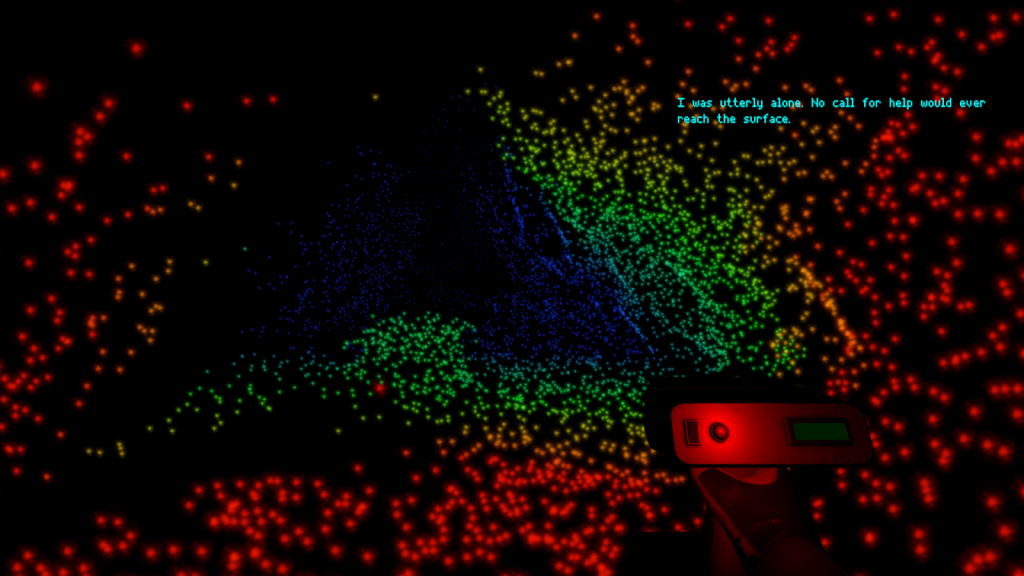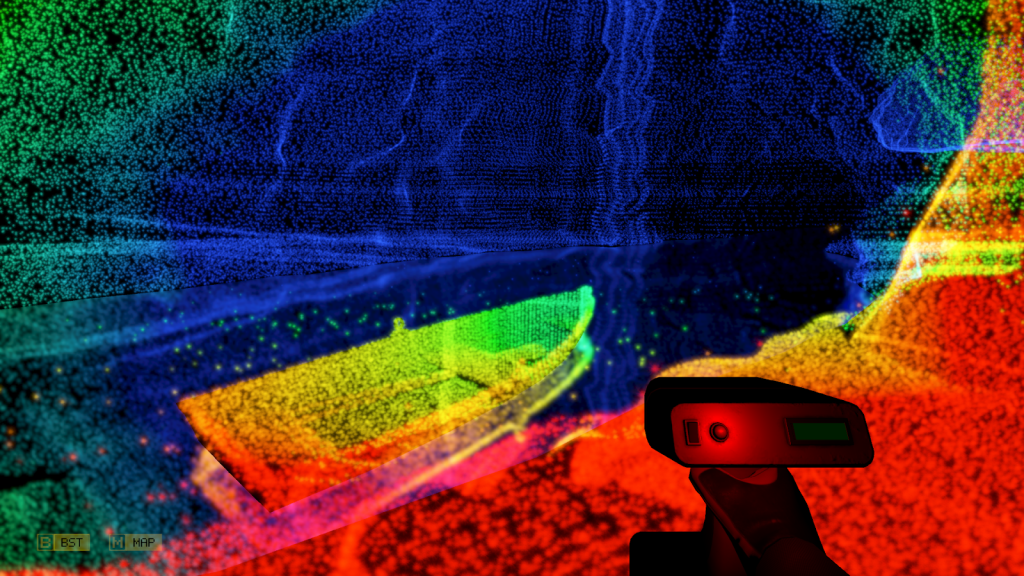With so many developers and titles to keep track of these days, I easily find myself picking games at random to play with no regards for what I am in the mood for. This eventually led me to discover Introversion Software, who made some of the most interesting projects I have ever witnessed. I first tackled their hacking-title Uplink, then jumped on their strategy game about nuclear war Defcon, before trying out their even stranger creations; Darwinia and Multiwinia. All of these are fascinating titles, with my personal favourite ending up being Prison Architect, simply because of how demanding it is.
With this in mind, why did I then choose to look at Scanner Sombre before any of the other games mentioned? Honestly, I wondered why a studio known for strange titles demanding player interactivity (with the strategy genre being their main one), decided to make a walking-simulator of all things. Walking-simulators can be done well, but most of my experiences with them result in the same amount of interactivity as navigating through a DVD menu: boring and uneventful. Can Introversion Software do more with their take on this genre?
I am sorry, but I do not care about your trivial monologues

Upon starting Scanner Sombre, you find yourself in a tent containing some necessary tools for surviving and some personal belongings. Stepping outside, you will acquire a pair of what looks like to be a VR headset and a scanner, functioning as a light source with the headset on. From this point on, there is really no way to go but forward. Unfortunately, as you start venturing further, your playable character will suddenly start monologuing about this cave with nothing insightful, before he then starts mourning about himself in the end portion.
This introduction to the game’s story might sound forced and shallow, but that is because the whole storytelling is. By having the main character talk about elements around him in a vague manner, we never get anything worthwhile about the areas or his take on them, making it easy to wish that he just went silent. This especially makes the journey underwhelming, when the protagonist’s interruptions indirectly tell you what you should make out of your discoveries .

This title is a great example of how to completely miss the mark of a media’s potential on how to tell a story. Less can be so much more, and that is why visual storytelling leaves a better impact in a visual media, and not someone mumbling incoherently. In fact, with how the game focuses on you discovering and learning about the world around you, I am shocked that they did not go all the way for creating a solid immersion. I can understand if they wanted to give the main character a reason to be here, but why not include elements that points back to him through subtle hints in the areas, instead of annoying monologues?
Even if you ignore your avatar talking to himself, the environments are sadly uninteresting too. There will be first a temple to witness, before more barren areas ending with a lake, which leads to a mine shaft to climb upwards in, and then the game ends. Sure, your camera will glitch and depict possible events that took place, but with no solid lore to anything inside this cave or subtle context to what went down, everything feels like cliches that are quickly shrugged off and forgotten about. It is all topped with an ending you can easily see coming and a soundtrack trying too hard to make every new area feel magical. Scanner Sombre does not take the player seriously, and thus I cannot say I will it either.
Story Score: 1/10
Potentials ruined by upgrades

Played from a first person perspective, Scanner Sombre takes on the walking-simulator genre as mentioned, but with a neat twist. Due to that you cannot see anything in this dark cave and do not have a flashlight, you will be given a device to scan the areas and use the particles you see through the headset in order to find your way forward. I love this idea as it gives the sense of you exploring this underworld, figuring out how it is constructed, and where you might be able to get further. Combine this with our protagonist only being able to jump and zoom in and out his sight, there was a lot to make you prepared for a dangerous and intriguing journey through these limitations.
The platforming is also solid, due to how you should make the actual platforms and pathways visually clear before you move onward, adding some tension to its simple mechanics. While your device is not waterproof and falling from great heights will kill you, the checkpoints are generous to not make backtracking a chore. However, what destroys this experience, are actually the upgrades you get. You will first acquire the burst scan, which scans an entire area and highlights everything in front of you. It is certainly helpful, but it is too convenient for letting you see the areas around you and only needs a short amount of time to recharge in order to be used again, making it neglect exploration.

Further making things uneventful, is a a map you will find that showcases where you need to go and where you have scanned. This again neglects the enjoyable exploration, because of how you will see the game’s linear structure, making the interesting concept of scanning the environments to find your way forward into a dull gimmick. Through these big issues, Scanner Sombre turns into just another walking-simulator with nothing to it. The game is further destroyed by one item that I will not spoil, besides saying that it is completely useless and destroys this game’s visual style.
Actually, the only upgrade I liked was the ability to widen and focus your spread of scanning, as it could either highlight more areas poorly or better specify smaller ones. That is pretty much all there is to this game, as it becomes less about finding the best method for progressing through this cave by utilising your scanning carefully, jumping correctly, and scaling tight ledges. Instead, Scanner Sombre becomes about what the map says, wait for the burst meter to be automatically filled up, and travel through levels that become more restricted and linear. This also includes a slow boat tour that is only used to make a big room seem magical.

Everything after the first 15 minutes is a bore. I was always checking my watch and wondering how long I had been playing, with what felt like six hours of playthrough only amounting to 80 minutes. I really wanted this title to be good as the concept was truly creative, but all the upgrades made it into a shallow idea in the end. Limitations can create vast experiences, and for an indie studio to not understand that is surreal and somewhat fascinating.
Gameplay Score: 3/10
Colours of the breeze
If there is one element I love about this game, it is its creative use of colours. Not only does it change gradually between red, yellow, green, and then blue in order to simulate distances from you and the objects, but the particles are mesmerising in order to create silhouettes and let the player figure out what is in front of them. This is also reflected on where you scan on an object, as it will only use particles on the area in front of you. Through this use of colours and particles, you can see far back of where you have already been and the shapes inside this cave, giving you a visualisation of your progression. I also love how other elements like water is showcased through subtle movements in the particles, making you always pay attention and get deep into the game’s art style.

As mentioned, this aspect is ruined by the last worthless upgrade in this game that would have at best been a fun reward for a new game plus mode. Sadly, it is not. There is a neat visual idea where the headset will glitch out to simulate memories of people that were in this cave, but they are as quickly forgotten about as they appear. The worst part, however, is that while there is a setup for letting the shapes tell a story through this cave’s structure and the objects it holds, there is little to speak of here. A simple lake, a temple to breeze through, and a mine shaft with wagons, all are just sort of there with no reason to explore further upon to gain any visual lore, making the shapes not impactful.
The soundtrack tries to add to the atmosphere, but it is such an unfortunate topic to tackle here. Not because the music is bad, it actually is quite lovely with subtle notes changing from dark piano tunes to a full out choir to make the adventure feel grand. Unfortunately, this is inconsistent. The game shifts drastically between an uncomfortable tone through silence and environmental sound effects, to a full out bombastic score to signify how in awe you are supposed to be. From a game with such an uneven tone, this comes off as forced. There is no shortage of quality put into the game’s presentation on a technical level, but it all falls hard when it is not utilised properly.
Presentation Score: 6.5/10
I am not going back!

There is a level select for the eight chapters, but because of nothing being interesting to revisit, having alternative takes for different outcomes or contain intriguing exploration, it is a useless option in this game. The same can be said for the new game plus, as it starts a new game with all the upgrades acquired. In fact, this is an even a worse way to start the game, as a run with limited supply where you do not pick up any upgrades, would have been more ideal.
Extra Score: 1/10
Verdict
I hate to be this harsh since Scanner Sombre clearly has potential to be something magnificent with its unique concept, but it tries to be more than what it is. By containing minimal setups in the environments to create a world, not letting the visuals tell a story, having a presentation that forces emotions, providing upgrades that destroy the game’s core idea, and no reason to replay the journey, Scanner Sombre becomes a frustrating piece of work. It can be atmospheric and it has potential to be worthwhile, but it is full of itself with no good structure. Why is this such a common thing for walking-simulators?

One thought on “Scanner Sombre”